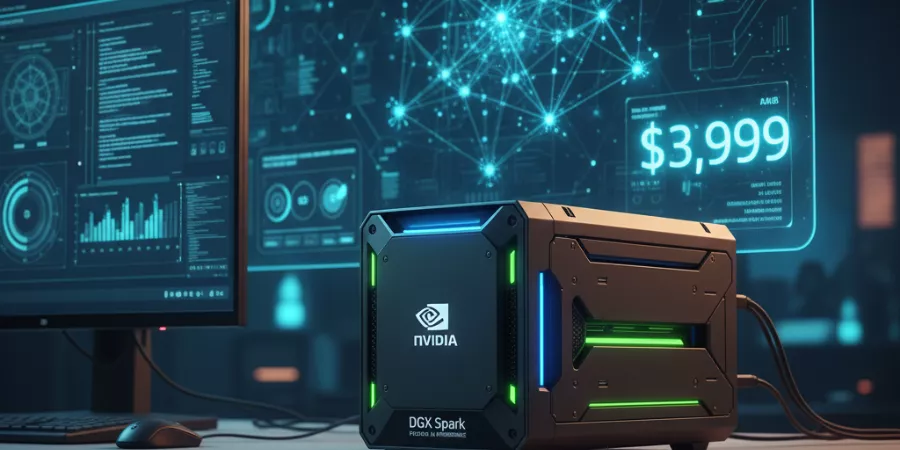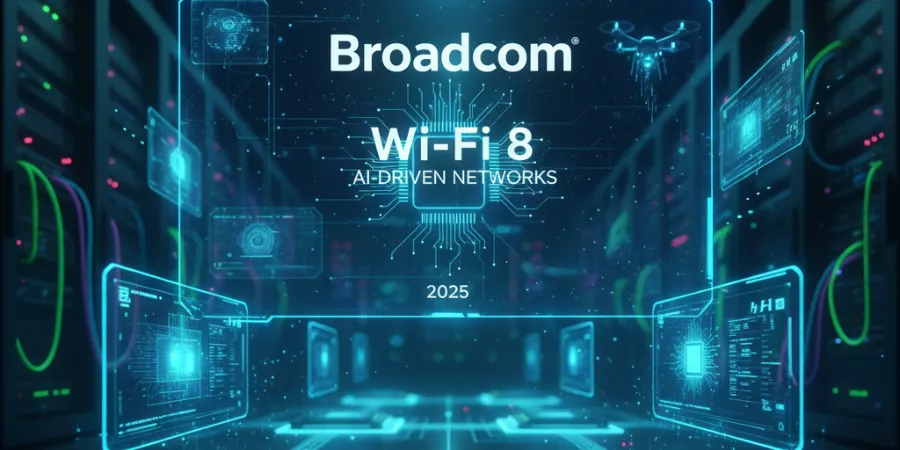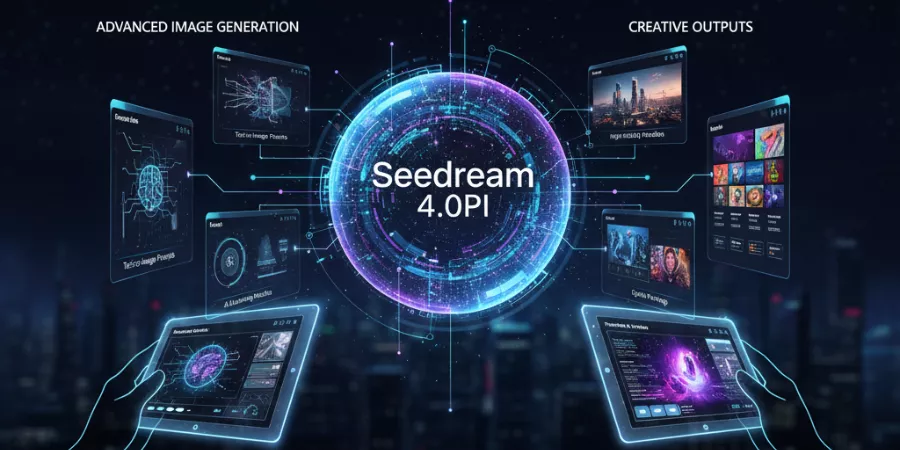Introduction
In a move that could democratize artificial intelligence development, Nvidia has launched the DGX Spark, a compact desktop system that delivers petaflop-scale AI performance and 128GB of unified memory. Starting October 15, 2025, developers can purchase what Nvidia calls “the world’s smallest AI supercomputer” for $3,999, bringing data center-class computing power to individual workstations.
In a symbolic gesture, Nvidia CEO Jensen Huang personally delivered the first DGX Spark unit to Elon Musk at SpaceX’s Starbase facility in Texas, echoing a similar 2016 delivery of the first DGX-1 to OpenAI, where Musk was a founding member. The moment underscores Nvidia’s vision of placing supercomputing power directly in developers’ hands rather than confining it to corporate data centers.
The DGX Spark: Redefining Desktop AI Computing
TIME Magazine recognized the DGX Spark as one of the Best Inventions of 2025, validating Nvidia’s engineering achievement in condensing enterprise-grade AI capabilities into a desktop form factor. The system addresses a critical bottleneck in AI development: the growing inadequacy of traditional PCs and workstations for modern machine learning workloads.
Technical Specifications and Capabilities
The DGX Spark is powered by Nvidia’s GB10 Grace Blackwell Superchip and can work with AI models locally with up to 200 billion parameters, supported by 128GB of unified system memory. This represents a paradigm shift in accessibility—capabilities that previously required cloud infrastructure or dedicated data center access are now available on a developer’s desk.
The system’s architecture delivers several breakthrough capabilities:
Performance Metrics: Up to 1 petaflop of AI performance enables real-time inference on large language models and complex neural networks without cloud dependency.
Model Scale: Developers can run inference on models up to 200 billion parameters and fine-tune models up to 70 billion parameters locally, covering the majority of practical AI development scenarios.
Expandability: Two DGX Spark units can be linked together to handle models with up to 405 billion parameters, providing a scalable path for researchers working with frontier models.
Software Integration: The system comes preloaded with Nvidia’s comprehensive AI software stack, eliminating setup friction and enabling immediate productivity.
Addressing the AI Development Bottleneck
The launch responds to a fundamental challenge in the AI industry. As model complexity and parameter counts have exploded—from millions to billions of parameters—traditional computing infrastructure has become increasingly inadequate. Developers face a choice between underpowered local machines and expensive, latency-prone cloud computing.
The rise of agentic AI systems capable of autonomous decision-making and task execution amplifies these demands, requiring developers to iterate rapidly on models that were impossible to run locally just months ago. The DGX Spark positions itself as a bridge solution, enabling local prototyping before scaling to cloud infrastructure.
Economic Implications for AI Development
At $3,999, the DGX Spark represents a significant investment for individual developers but offers compelling economics compared to alternatives. Cloud GPU instances for comparable workloads can cost hundreds to thousands of dollars monthly, creating substantial recurring expenses for continuous development work. The DGX Spark’s one-time cost could achieve ROI within months for serious AI developers.
This pricing strategy also democratizes access to cutting-edge AI capabilities. Research institutions, startups, and individual developers who previously couldn’t justify dedicated GPU clusters or sustained cloud spending now have a viable entry point to advanced AI development.
Industry Adoption and Ecosystem Support
Nvidia’s partners including Acer, ASUS, Dell Technologies, GIGABYTE, HP, Lenovo, and MSI are shipping DGX Spark systems, ensuring broad distribution channels and potential hardware variations. Early recipients include major technology companies such as Google, Meta, Microsoft, Hugging Face, and Docker, alongside academic institutions like NYU’s Global Frontier Lab.
This early adoption by industry leaders validates the system’s capabilities and suggests potential integration into enterprise development workflows. When companies like Meta and Microsoft—which operate massive AI infrastructure—still see value in desktop-class AI systems, it signals a shift in how AI development cycles are structured.
The Software Ecosystem Advantage
The DGX Spark runs on DGX OS, Nvidia’s Linux-based operating system optimized specifically for AI development. Unlike general-purpose workstations that require extensive configuration, the DGX Spark ships ready for immediate AI workloads. This turnkey approach removes a significant barrier to entry, particularly for developers transitioning from cloud-based development.
The preinstalled software stack includes frameworks, libraries, and tools that typically require hours or days to configure correctly. By standardizing this environment, Nvidia creates consistency across development, testing, and production deployment—a crucial advantage for teams scaling AI applications.
Strategic Context: Nvidia’s Desktop Computing Vision
The DGX Spark launch represents Nvidia’s latest effort to expand beyond data centers into personal computing. The company has systematically built offerings spanning cloud infrastructure (DGX Cloud), enterprise systems (DGX Station), and now desktop devices, creating a continuum from prototyping to production deployment.
This vertical integration strategy allows developers to prototype on DGX Spark, validate on larger DGX systems, and deploy at scale on DGX Cloud—all within Nvidia’s ecosystem. This seamless workflow reduces friction in the development pipeline and potentially locks developers into Nvidia’s hardware and software stack.
Competitive Landscape and Market Positioning
While competitors offer GPU-accelerated workstations, few match the DGX Spark’s combination of compact form factor, unified memory architecture, and integrated software stack. Apple’s M-series chips offer strong inference performance but lack the training capabilities and ecosystem integration that Nvidia provides. AMD and Intel continue developing AI accelerators but haven’t yet matched Nvidia’s software ecosystem maturity.
The DGX Spark’s 128GB unified memory architecture—where CPU and GPU share the same memory pool—eliminates data transfer bottlenecks that plague traditional discrete GPU systems. This architectural advantage, inherited from the Grace Blackwell design, provides performance benefits that pure GPU specifications don’t capture.
Implications for the AI Development Ecosystem
The availability of desktop AI supercomputers could accelerate innovation by enabling more developers to experiment with large-scale models. Currently, cutting-edge AI research concentrates in well-funded labs with substantial compute budgets. The DGX Spark lowers these barriers, potentially diversifying the pool of contributors to AI advancement.
Educational institutions particularly stand to benefit. Universities can equip labs with DGX Spark systems, giving students hands-on experience with models and workflows that mirror industry practices. This practical exposure could better prepare graduates for AI careers while advancing academic research.
Privacy and Data Sovereignty Considerations
Local AI development on DGX Spark also addresses growing concerns about data privacy and sovereignty. Organizations handling sensitive data can develop and fine-tune models entirely on-premises without transmitting proprietary information to cloud providers. This capability proves particularly valuable in regulated industries like healthcare, finance, and defense.
The ability to run inference locally also reduces latency and eliminates internet dependency, crucial for applications requiring real-time responses or operating in network-constrained environments.
Frequently Asked Questions
Q: What makes the Nvidia DGX Spark different from a gaming PC with a powerful GPU?
A: The DGX Spark uses Nvidia’s GB10 Grace Blackwell Superchip with 128GB of unified memory shared between CPU and GPU, enabling it to handle AI models up to 200 billion parameters. It comes preloaded with Nvidia’s AI software stack and runs the specialized DGX OS, providing a turnkey AI development environment that gaming PCs can’t match.
Q: Can individual developers afford and justify the $3,999 price tag?
A: For developers currently relying on cloud GPU instances, the DGX Spark can achieve ROI within months. Cloud GPU costs for comparable workloads often exceed hundreds of dollars monthly. The system targets serious AI developers, researchers, and small teams who need consistent access to high-performance AI computing without recurring cloud expenses.
Q: What size AI models can the DGX Spark handle?
A: The DGX Spark can run inference on models up to 200 billion parameters and fine-tune models up to 70 billion parameters. When two units are linked together, they can handle models with up to 405 billion parameters, covering most practical AI development scenarios including large language models.
Q: Why did Jensen Huang deliver the first unit to Elon Musk?
A: The delivery symbolically connected to the DGX supercomputer’s origins. In 2016, Huang delivered the first DGX-1 to OpenAI, where Musk was a founding member. That system contributed to the development of technologies behind ChatGPT. The gesture at SpaceX’s Starbase highlights the connection between AI advancement and space exploration.
Q: When and where can I purchase a DGX Spark?
A: The DGX Spark became available for purchase starting October 15, 2025, through Nvidia.com and partner systems from Acer, ASUS, Dell Technologies, GIGABYTE, HP, Lenovo, and MSI. Availability may vary by region and partner.
Conclusion: A New Era for Desktop AI Development
The Nvidia DGX Spark represents more than incremental hardware improvement—it signals a fundamental shift in how AI development can be conducted. By bringing petaflop-scale performance to desktops, Nvidia democratizes access to capabilities previously confined to corporate data centers and well-funded research labs.
Jensen Huang’s hand-delivery to Elon Musk at SpaceX’s Starbase facility symbolizes the company’s ambition: to spark the next wave of AI breakthroughs by placing powerful tools directly in developers’ hands. Whether the DGX Spark achieves this lofty goal depends on adoption rates and the innovations it enables, but the technical achievement is undeniable.
For AI developers, researchers, and organizations navigating the rapidly evolving landscape of artificial intelligence, the DGX Spark offers a compelling proposition: enterprise-grade AI computing without the enterprise infrastructure requirements. As AI continues its trajectory from specialized research to ubiquitous technology, tools like the DGX Spark may prove pivotal in determining who can participate in shaping that future.
















